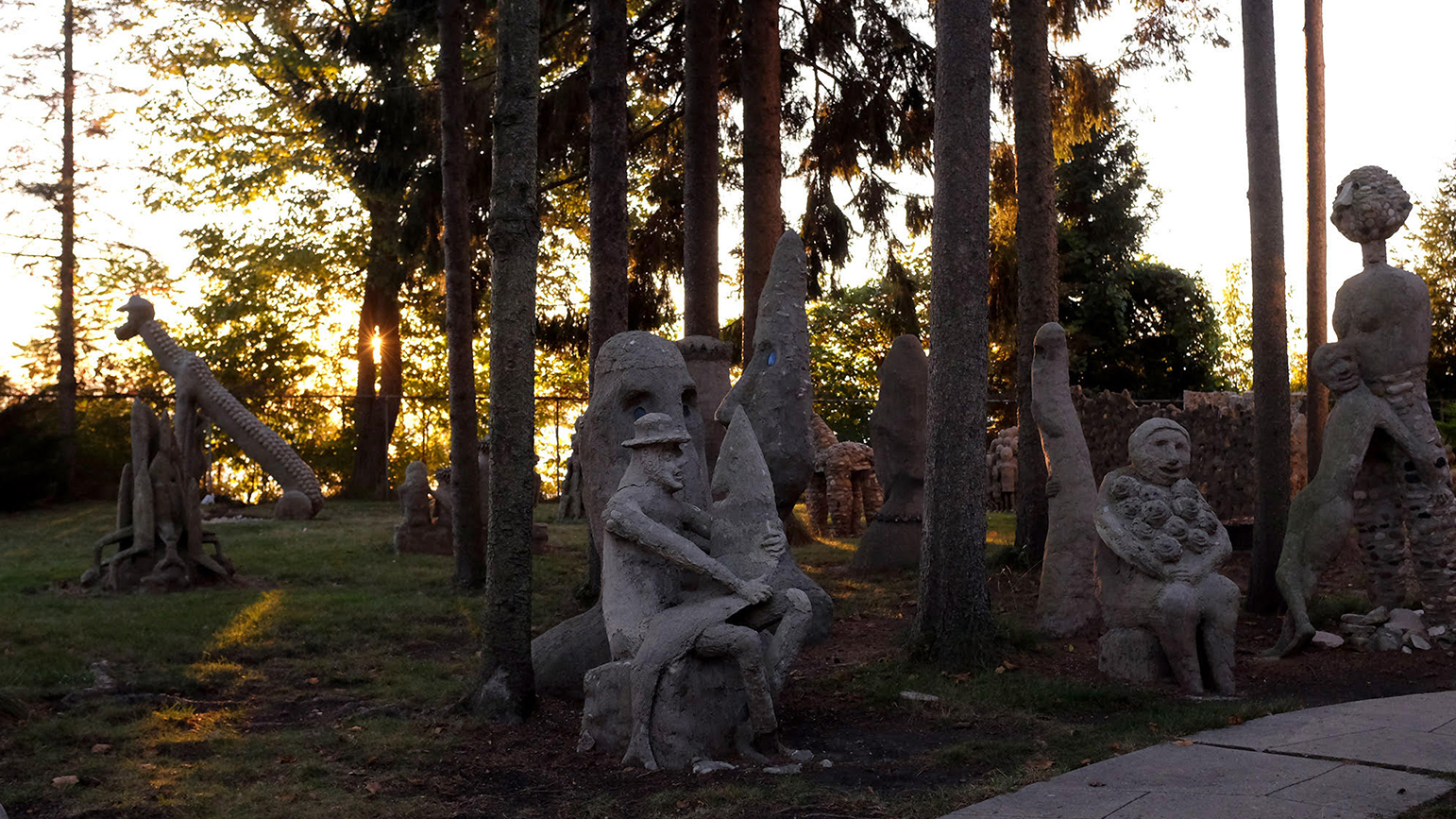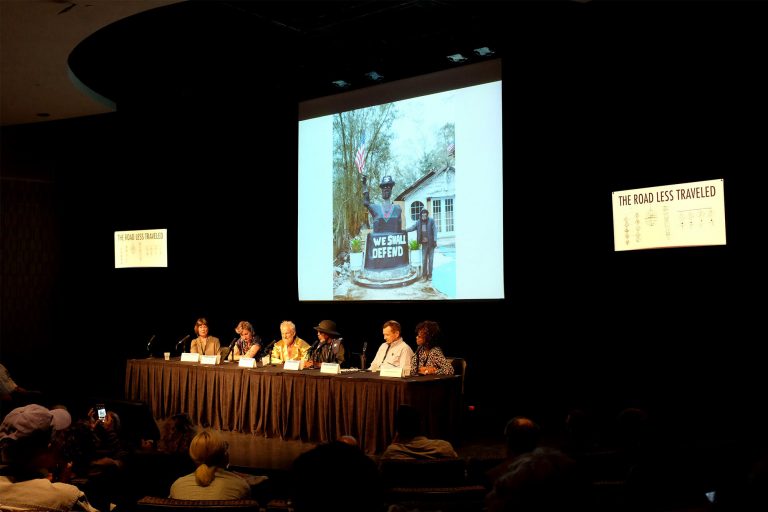
“A man stopped and was reading my signs, I asked him in and to sign my registry book, which he did, and make some remark about my work, which he did. He said, keep on giving them hell, they = have = it = coming.”
– Jesse Howard (1)
Late last fall, artists, scholars, conservators, and aficionados gathered at for The Road Less Traveled Conference at the John Michael Kohler Arts Center in Sheboygan, Wisconsin to discuss the preservation, promotion, and stewardship of artist-built environments. What exactly is an “artist-built environment” the reader may ask? Like many things, Justice Stewart’s 1964 pornography test could provide the best standard: you know one when you see one. This is a subjective defining strategy to be sure, and intentionally so. “Any objective approach to the grass-roots artist is irrelevant,” wrote Gregg N. Blasdel in his seminal 1968 Art in America essay on the genre, coining one of many terms applied to these creators. “By the very nature of his situation, he transcends analytical judgements and generalizations.”(2) For the uninitiated then, some examples of what does and what does not constitute an artist-built environment might prove helpful: Leonard Knight’s Salvation Mountain: Yes, Gutzon Borglum’s Mount Rushmore: No. Loy Bowlin’s Beautiful Holy Jewel Home: Yes, Art Schmock’s One Log House: No. Dr. Evermor’s Forevertron: Yes, Alex Jordan Jr.’s House on the Rock: No. Noah Purifoy’s Outdoor Desert Art Museum: Yes, Andrea Zittel’s Planar Pavilions: No. Wait, maybe? I’m not sure about those last two. And that is, of course, part of the fun.
The presentation, interpretation and safeguarding of these spaces is the core mission of the Art Center (acronymed as the difficult-to-pronounce JMKAC). Since 1983, JMKAC has amassed tens of thousands of objects made by artists who have been referred to historically as naive or folk or outsider or intuitive or self-taught or vernacular or visionary artists (with this last term the one currently en vogue).
This narrow terminology, however, does little to represent the broad field of study surrounding these spaces and their diverse creators. Artists grouped under this umbrella are neither universally poor nor rich, neither rural nor urban, neither academically trained nor self-taught, neither crazy nor sane. Similarly, creators do not conform across race or gender. Most own the property on which they create, but others rent or squat on the land. And while the majority of the environments discussed over the course of the conference are clustered in the upper Midwest (3), examples can be found around the globe.
Two commonalities, however, link these environment builders better than any prefix. First: their voices have been largely ignored by mainstream art communities during their lifetimes. Excluded from commercial gallery representation or substantial institutional support, their work has often gone under or unrecognized. But, to continue to complicate our working definition, this exclusion has sometimes been self-imposed. Second: these environment builders are deeply rooted in place. Whether the artist is regarded a minor genius, an eccentric regional celebrity or a reviled problem neighbor, they are part of the locale in which they create and reside.

Over the course of The Road Less Traveled conference, conversations returned to this linkage to the local. Created in and for basements, garages and living rooms, these artists’ works are intimate. They are often made in the home and, in many instances, constitute the home itself. These spaces provide an unexpected splash of color amongst a sea of faded vinyl siding and neglected clapboard shingles. Proliferating in the liminal public-facing but privately-owned space of the front yard, these environments cause curious passersby to pull their cars over. They are attractive curiosities – places people want to see and actively seek out. Today, it is easy to “discover” these environments through roadside Americana guide books and on webpages ranging from the niche Spaces Archives to the ubiquitous Atlas Obscura to the inescapable Yelp. Despite the historical animosity from municipalities and neighbors faced by these artists during their lifetimes, many of these environments have been posthumously embraced for their tourist appeal.

Sheboygan, Wisconsin is a town of just under 50,000 residents on the western shore of Lake Michigan. The Kohler Company, a family-owned, Wisconsin-based manufacturer of bathroom ceramics, plumbing fixtures, and more, has an annual revenue of six billion dollars and employs 35,000 people internationally.
Since the late 1960s Ruth Kohler (daughter of JMKAC’s namesake) has facilitated the preservation of dozens of artist-built environments in conjunction with the Kohler Foundation’s Terri Yoho. The duo have historically been the last and only chance at preservation of these sites before they are bulldozed by the bank or liquidated by estranged relatives. This last minute, frantic, stop-gap preservation is a challenging staple of the centers mission. As curator Karen Patterson noted, it isn’t unreasonable to assume that JMKAC’s holdings could jump by several thousand items quite quickly, growth that might swell the total collection from say, 25,000 to 30,000 items in a months’ time. This potentiality for unpredictable growth exists parallel to a new and innovative curatorial program spearheaded by Patterson positioning works from JMKAC’s collections in dialogue with contemporary artists. A lot happens under one roof.
The Road Less Traveled conference also marked the imminent retirement of both Ruth Kohler and Terri Yoho from their respective leadership positions. In anticipation of this transition, Friday’s Parking Garage panel featured the unveiling of Ruth Kohler’s final initiative: a new museum building called The Art Preserve. Situated on an undeveloped parcel of land on the outskirts of Sheboygan and designed by the Denver-based Tres Birds Workshop, this ambitious structure will serve simultaneously as as exhibition space, deep storage, and accessible archive. The goal, according to Kohler, is to have every object and environment in the collection on view simultaneously. Visitors will be able to see everything all at once, in one place. Environments owned by JMKAC, like Loy Bowlin’s Beautiful Holy Jewel Home, will be on long-term display, sparing the delicate works the stress of repeated cycles of installation and storage. “Much like the artists’ original sites,” toutes the JMKAC website, “the new facility will offer multiple visitor experiences, from academic exploration to meditative consideration to exciting personal discovery.”
This, truly, is the difficult and exciting challenge for those gathered for The Road Less Traveled conference: bridging the vernacular and the institutional. Despide Blasdel’s 1968 assertion that these works “transcend analytical judgements,” there is important scholarship happening surrounding these sites. And now is the time. JMKAC’s mission to preserve, study, and contextualize these precarious artist-built environment becomes ever more important as art historical hierarchies of geographical and educational privilege continue to reveal themselves as fallacies.
“On The Ground” is a series featuring research by graduate School of Art students at Carnegie Mellon University that offers a glimpse into the particular contexts, processes, and methods of inquiry that drive their work beyond the confines of the studio.
(1) The Mary Nohl’s front yard sculptures, Fox Point, Wisconsin
(2) The Lane Changes, Game Changers panel, with (L-R): Roger Brown Study Collection director Lisa Stone, Philadelphia’s Magic Gardens’ Emily Smith, Artist Isaiah Zagar, Artist Dr. Charles Smith, Photographer Fred Scruton and the Heidelberg Project director Jenenne Whitfield.
(3) Robert Aiki Aubrey Lowe performing with Harry Bertoia’s sculptures in an exhibition at JMKAC featuring Bertoia and Emery Blagdon’s Healing Machine (c. 1950–86), organized by Shannon Stratton.
(2) Gregg N. Blasdel, “The Grass-Roots Artist,” Art in America (September-October 1968): 24
(3) Panelists and attendees again and again acknowledged Lisa Stone and Jim Zanzi as deeply influential scholars within this field of study. Many younger conference goers eagerly identified as alumni of the duo’s co-taught Better Homes & Gardens course at the School of the Art Institute of Chicago. Stone is also the director of the Roger Brown Study Collection, an archive of the Chicago Imagist’s personal holdings bequeathed to SAIC and housed today in the artists’ Halsted Avenue home. Brown and his artistic cohort were heavily influenced by and an avid collector of “nonmainstream artists, folk and tribal art” (according to the Study Collection website). One must wonder if the Midwest is home to a sizeable conglomeration of artist-built environments is the result of more examples being clustered there or if more of these spaces simply been documented and analyzed in the area as a result of the local conflux of Stone, Zanzi, JMKAC and the Chicago Imagists? Is there something inherently distinct geographically, culturally, environmentally, or historically in the Midwest that fostered the creation of these spaces? Or have they simply been more thoroughly looked at there?




